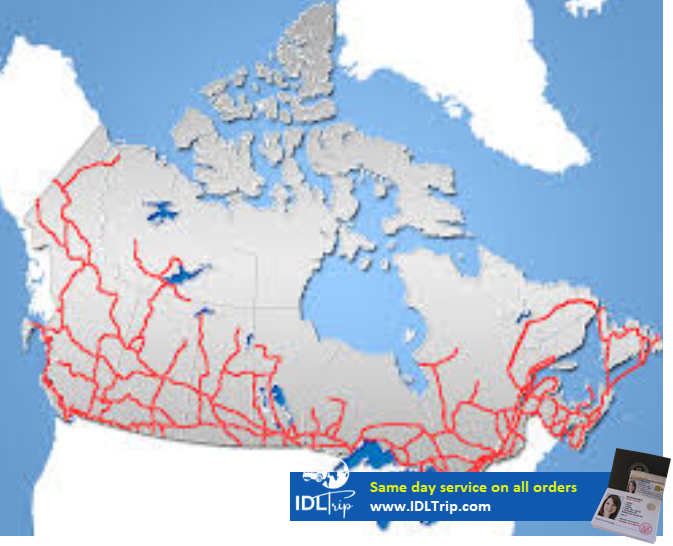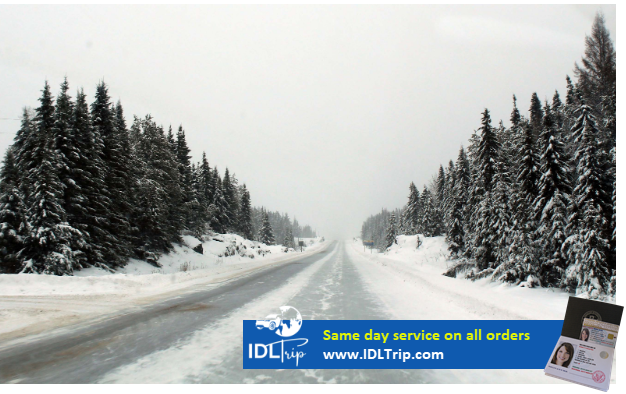Canada Roads
Driving in Canada is one of the best ways to savour the sights of this vast country. While you can certainly get by without a car in the major cities, many scenic smaller towns and national parks are only accessible by car. And one of the reasons for visiting Canada is for the great outdoors and the wildlife.
Canadian roads are quite long: Canada is a country that spans six time zones! Therefore always carry food and water with you while traveling long distances. Accidents due to fatigue and drowsiness are common.

Unlike in the United States, all road signs in Canada use metric units. Distance and speed are marked in kilometres and kilometres/hour. Most American cars have speedometers that display both units but if yours doesn't, keep in mind that one mile is about 1.6 km.
Although Canada is the second largest country in the world by land area after Russia, its population is only about one tenth that of the United States. Most of that population is concentrated within 200 km from the US border. Outside the Windsor-Quebec corridor distances are often vast and easy to underestimate; you may have to travel hundreds, or even thousands of kilometres before you can see the next trace of civilisation.
Motorists who wish to head off the beaten track need to be prepared for the elements, especially during Canada's notoriously harsh winters, and a satellite phone may be worthwhile investment if you are travelling to really remote areas.
Driving laws and rules
You must follow Canada’s driving laws. Before you start driving, take time to learn the laws in your province or territory. For a full list of laws and rules about driving, get a copy of the driving guide issued by the department that regulates cars and driving in your province or territory. You can usually get these guides at service centres, online and in stores. Driving laws are strictly enforced in Canada. Penalties for breaking the law are generally severe. Read about some of the most important laws to know. To legally drive a car in Canada, you'll need a driver's licence issued by the government of your province or territory. If you plan to use a foreign driver's licence in Canada, you should get an International Driving Permit in your home. Insurance is required in all states and you might not be able to buy insurance with a foreign license. It is easier to buy insurance with an International Driver's Permit. You need a valid driver's license to drive a car in Canada. U.S. drivers licenses are valid in Canada but visitors from other countries are advised to get an international driver's license. In addition, proof of auto insurance is required. U.S. auto insurance is accepted if you are a tourist in Canada. The IDP or International Driving Licence is a translation of your driver's licence from another country into many languages. You must have a valid driver's licence from another country to use it in Canada.
If you’re in an accident
It’s a serious crime to leave the scene of the accident. This includes accidents with another vehicle or hitting a pedestrian. If you’re in an accident:
-call the emergency number (911) for police and an ambulance (if you need one)
-wait at the scene until the emergency services you called arrive
-exchange information with the other driver (if the accident involves another vehicle), including: name, address, telephone number, licence plate, driver’s licence numbers, insurance company name. insurance plan number.
Drinking and Driving
Driving while impaired is a criminal offense in Canada. Penalties are heavy, and any prior conviction (no matter how old or how minor the infraction) is grounds for exclusion from Canada.
Canada has very strict laws on drunk driving, which is not just a traffic violation, but a very serious social taboo and a criminal offence in Canada. Under provincial highway traffic acts, the legal maximum blood alcohol level ranges from 0.04 in Saskatchewan to 0.08 in Alberta and Quebec (80 mg of alcohol in 100 mL of blood).
Buying or leasing a car
You can search the Internet or call the local transportation ministry in your city to find out about car dealers or car rental agencies.If you only need a car for short periods, you can rent a car from a car rental agency. Make sure car insurance is included in your car rental agreement if you need it.In some cities, there are car-sharing programs that let you use a car without buying, leasing or renting.
Winter driving in Canada
Exploring Canada by road doesn’t have to be limited to the summer season. Winter road trips offer low crowds, cheaper prices and wonderfully snowy scenery. But there are undoubtedly more challenges.
Winter driving in Canada can be a scary and dangerous experience.It’s hard to drive on icy roads before, and will know what it’s like trying to cope when the temperature hovers around -1°C or -2°C. But there’s a huge difference between that, and driving on a secluded highway at night, when it’s -25°C and there’s no cellular service. One wrong manoeuvre can be deadly.So it’s with good reason that provinces have strict rules around winter driving in Canada. Here are some of the things all newcomers should keep in mind.

All provinces recommend switching to winter tires when the temperature falls below 7°C. Canadians need to plug in their cars in winter. it’s not because they’re electric cars that need a charge. It’s because the weather is so cold, that they actually need to hook up a heater just to keep crucial parts of their engine working!
Vancouverites may escape this, seeing as winter temperature generally stay above freezing.Cold weather means the oil in your car becomes thicker. ‘Block heaters’, as they’re known, ensure that your car’s engine and oil stay warm. They should be turned on between two and four hours before you drive, depending on how severe the cold is.
Every car should have the following supplies.
- Warm clothes and blankets. Be sure to include gloves, a warm hat, and boots.
- Non-perishable food, like cereal, chocolate, or granola, and water.
- First aid kit.
- Printed road maps – don’t depend on your phone or GPS for longer journeys.
- Torch and spare batteries.
- Small candles – in case the batteries stop working in cold temperatures. Bring a tin they can be stored and carried in.
- Heat packs. These are small packs that, when snapped like neon glow sticks, generate heat and can be placed inside your gloves or boots to stay warm.
- Sunglasses – essential when the sun illuminates a layer of fresh snow.
- De-icer or WD-40 to defrost your locks. By day, water can get into your keyhole, and freeze when temperatures dip at night.
- Shovel (buy one with a small handle so it can fit in your car).
- Bag of grit, or kitty litter.
- Waterproof matches.
- Booster cables.
Be prepared for short driving days
Daylight is limited in the winter. I don’t know about you, but I hate driving in the dark, especially during winter when blizzards, black ice and freezing rain is all possible. On our winter road trip in Canada, we drove when the sun was coming up and generally stopped soon after it went down. This reduced our driving window to approximately 7am – 4pm, depending on time zone and location. Don’t forget that if you drive across Canada you will be passing through a number of different time zones! Remember that the time of sunrise and sunset will vary as you drive across different provinces and territories.
Pick your destinations carefully
You’ve probably already guessed, but due to adverse weather conditions and lack of visitors, many attractions in Canada have either reduced hours or are completely closed in winter. A lot of provincial and territorial parks will have limited access or will be completely closed to visitors.

